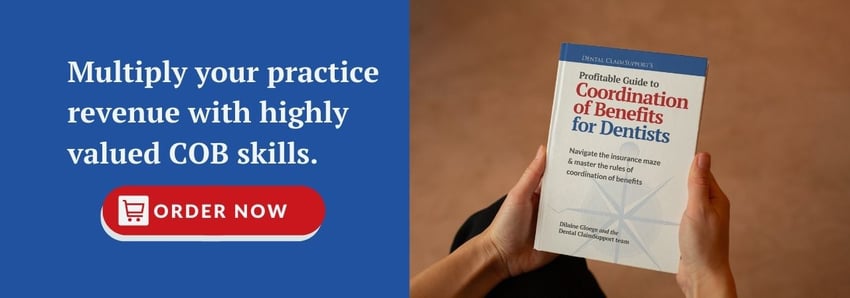Dental Coordination of Benefits: File in the right order with these rules


Coordinating benefits for patients with dual insurance can be challenging and, well, annoying. But you, being a dental professional, need to understand how to handle dual dental insurance coverage. Not only can you help your patients lower their out-of-pocket expenses. You can help your office financially by collecting all available payments.
Understanding coordination of benefits (COB) can be difficult. The order of benefits follows rules to determine primary, secondary plans and beyond. Some plans work differently, some states work differently. Handling COB and the aspects of dual insurance is literally the #1 issue dental offices and billers face in the U.S. Our company, Dental ClaimSupport, works with offices nationwide, so I can say this without hesitation.
COB rules are lot to learn and keep up with. But when you start learning coordination of benefits for dental billing, you become more efficient, can collect the maximum from the benefits available, and build trust with patients because you handle their dental benefits correctly.
This article will address what dental COB is, who establishes the rules and why understanding COB is important for dental claims. There are many moving parts to learn about COB and many different scenarios. We will stick to the basics here, so you can go about your dental billing confidently with the knowledge your patients and dental office need.

So, what is coordination of benefits in dental insurance?
Coordination of benefits establishes the order claims are paid, known as primary, secondary, tertiary, quaternary, etc. Yes, a patient can have four plans in some instances! For example, a 24-year-old patient may be covered under her employer plan, spouse plan, father's plan, and mother's plan.
How can this be? The Affordable Care Act (ACA) mandates that all dependents up to age 26 be eligible for healthcare benefits under the parent's plan. While the ACA rule applies only to medical policies, many employers allow dependent eligibility for dental coverage up to age 26 to keep the benefits package simple.
When a patient has coverage under more than one plan, the order of benefits should be determined prior to submitting any claims to prevent any overpayment. COB rules are in place to ensure the total benefit paid does not exceed the total amount of fees billed. I know, it happens on occasion and in some instances, collecting more than billed is legitimate. This only occurs when one or more plans do not coordinate benefits - very rare.
Who establishes the order of benefit rules?
Ultimately, each plan has an established coordination of benefits rule and the practice must adhere to the plan rules. However, there are governing bodies that come into play. Let’s first look at state laws.
A fully insured plan will follow any established COB rules of the state in which the plan was sold. In fact, a fully insured plan will follow any state insurance laws and fall under the jurisdiction of the state insurance commissioner of the state in which the plan was sold. These type plans are usually small group plans or individual plans.
A self-funded or federal plan does not follow any state insurance laws including but not limited to COB rules. Self-funded and federal plans don’t fall under the jurisdiction of any state insurance commission. These plans follow the Employee Retirement Income Security Act (ERISA), which is federal law. This is where COB becomes confusing and challenging. So, why is it so confusing? First of all, each plan establishes its own COB rules. About 65% of all dental plans in the average practice are either self-funded or federal plans. Wow, that’s a lot of different rules.

Recommended COB rules to guide dental billing
The National Association of Insurance Commissioners (NAIC) has published a recommended COB model. The key word is recommended. There is no requirement for a plan to adopt the NAIC COB model rules. Most states have chosen to adopt the NAIC COB model rules. The NAIC rules are often used as a guideline when plans are establishing their rules but again, there is no requirement. Therefore there is no clear standard that applies to all dental plans across the board.
Below are a few common NAIC recommended COB models when determining the order of benefits.
Active Employee or Retired or Laid-off Employee.
The Plan that covers a person as an active employee, that is, an employee who is neither laid off nor retired, is the Primary plan. The Plan covering that same person as a retired or laid-off employee is the Secondary plan. The same would hold true if a person is a dependent of an active employee and that same person is a dependent of a retired or laid-off employee. If the other Plan does not have this rule, and as a result, the Plans do not agree on the order of benefits, this rule is ignored.
For a dependent child whose parents are divorced or separated or not living together, whether or not they have ever been married:
(i) If a court decree states that one of the parents is responsible for the dependent child’s health care expenses or health care coverage and the Plan of that parent has actual knowledge of those terms, that Plan is primary. This rule applies to plan years commencing after the Plan is given notice of the court decree;
(ii) If a court decree states that both parents are responsible for the dependent child’s health care expenses or health care coverage, the provisions of Subparagraph (a) above shall determine the order of benefits;
(iii) If a court decree states that the parents have joint custody without specifying that one parent has responsibility for the health care expenses or health care coverage of the dependent child, the provisions of Subparagraph (a) above shall determine the order of benefits; or
(iv) If there is no court decree allocating responsibility for the dependent child’s health care expenses or health care coverage, the order of benefits for the child are as follows:
The Plan covering the Custodial parent;
the Plan covering the spouse of the Custodial parent;
the Plan covering the non-custodial parent; and then
the Plan covering the spouse of the non-custodial parent.
COBRA or State Continuation Coverage
(a) If a person whose coverage is provided pursuant to COBRA or under a right of continuation pursuant to state or other federal law is covered under another plan, the plan covering the person as an employee, member, subscriber or retiree or covering the person as a dependent of an employee, member, subscriber or retiree is the primary plan and the plan covering that same person pursuant to COBRA or under a right of continuation pursuant to state or other federal law is the secondary plan.
(b) If the other plan does not have this rule, and if, as a result, the plans do not agree on the order of benefits, this rule is ignored.
(c) This rule does not apply if the rule in Paragraph (1) can determine the order of benefits
Just because you're learning the "basics" of dental insurance, doesn't mean it's easy
We may have just learned the basic definitions of a few insurance terms such as coordination of benefits, but that by no means makes it easy or simple. It’s a lot to remember, and can be complicated when applying these terms to real life.
For more help on trying to wrap your head around these dental insurance terms, sign up for our Dental Claims Academy training webinars. It’s career training for anyone working in a dental practice to stay informed on coding, regulations and all the other essential details that help you and your practice succeed.
Related Posts
Dental revenue resources from Dental Claim Support

